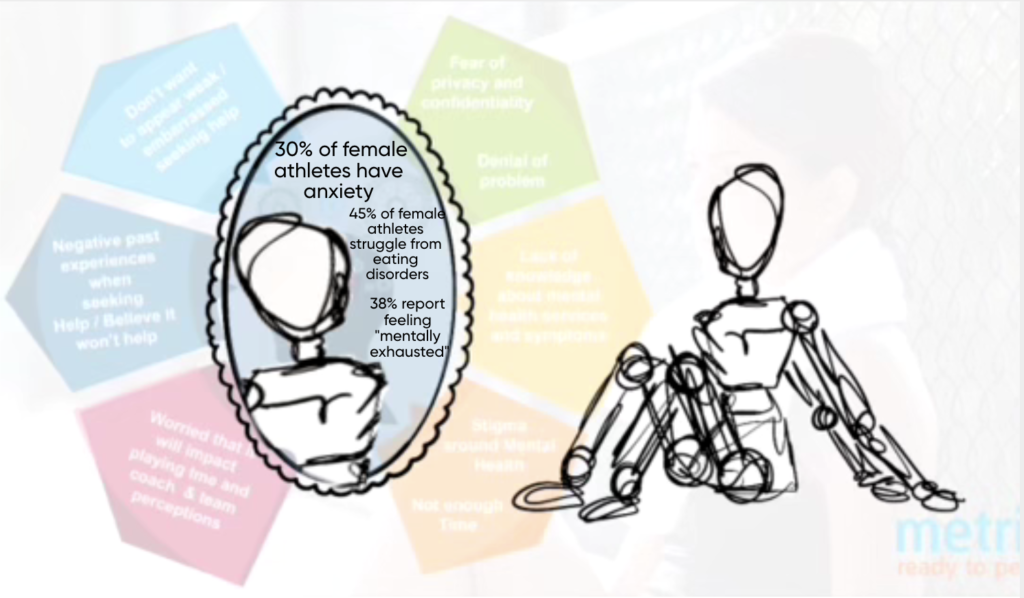Young female athletes often face criticism on their appearance, regardless of their body type (Hardie et al. 2022). This scrutiny perpetuates outdated gender norms, where boys are praised for traits like strength and assertiveness, and girls face backlash for the same qualities. This double standard contributes to mental health struggles among female athletes and further influences their quest for perfection (Schwarz et al. 2005).
Underrepresentation in the media exacerbates these challenges, as young female athletes lack positive role models and visibility. However, a shift is occurring, as media representation gradually improves, offering more diverse and empowering portrayals of female athletes for girls to look up to.
Underrepresentation and Stereotyping in the Media
In the media, gender stereotypes portray men as strong and aggressive, while women are expected to embody grace and delicacy (Sherry, Osborne, and Nicholson, 2016). Organized sports have historically reinforced male dominance, in part by segregating sports by gender. A study by Scheadler and Wagstaff (2022) indicate that less than 10% of sports media covers women’s sports, with less than 2% covering those perceived as masculine, further marginalizing female athletes and hindering their recognition and support. Similarly, Jessica Shaller’s (2006) research highlights that from 2000 to 2006, only 5% of Sports Illustrated covers featured women, of which merely 40% were depicted in action, reinforcing stereotypes and undermining their credibility.

The image above contrasts Roger Federer actively playing tennis with Anna Kournikova depicted in a seductive pose in a Sports Illustrated magazine.
The Toll of Perfectionism on Female Athletes’ Mental Health
The media’s idea of “perfection” significantly impacts female athletes, creating unrealistic and unfair standards of idealized physical appearance which in turn causes negative body image (Midgley et al. 2021).
Social comparison theory explains why people act in ways that compare themselves to people they see in the media (Hardie et al. 2022). A journal article by Schwarz said that 90% of women compare themselves to people on social media, 40% of which they say is a negative comparison. The constant cycle of comparison detracts female athletes’ focus on personal growth and achievement, fostering feelings of inadequacy and undermining their self confidence (Shwarz et al. 2005).
Perpetuating this ideal contributes to disordered eating, diminished self-worth and hindered personal development (Schwarz et al. 2005). Up to 45% of female athletes struggle from eating disorders, highly attributed to the way female athletes compare themselves to what they see in the media (Rittenhouse 2024). The stigma that is associated with not being “perfect” and suffering because of it, prevents female athletes from seeking necessary support or help for they fear being perceived as weak (Midgley et al. 2021).

Breaking Barriers: Women in Male Dominated Sports
The increasing participation of women in sports traditionally associated with men, challenges existing notions of female inferiority and weakness. When female athletes assert control over their bodies, they confront these stereotypes. Yet, defying these norms may lead to female athletes being deemed as less feminine. Despite these challenges, female athletes consistently demonstrate their ability to compete at par when afforded equal resources (Huggins and Randell, 2007).
(E. Zelmer, 2017)
Media Milestones: Coverage on Female Athletes Increases
There have been a few indications that the media’s portrayal of female athletes is changing. Procter & Gamble’s brand, Always feminine hygiene products, released a commercial asking young and teen females and males what it means to do something “like a girl.” When prompted to “run like a girl,” the teen participants flapped their arms, messed with their hair, and acted in exaggerated, stereotypical movements. When posed with the same question, young girls appeared to be strong, serious about the running, and demonstrated an intensity in their faces that was absent in the teens. Advertising brands are beginning to recognize the power of media and their role in portraying what it truly means to “be a girl.”
While female athletes continue to be misrepresented in the media, there has been notable progress. As recently as 2022, the women’s college basketball championship couldn’t use March Madness branding because of concerns that it would detract from the publicity of men’s basketball. Womens’ basketball wasn’t considered to be as fun to watch as men’s basketball (Moreno 2024). However this was proven wrong on April 7, 2024.
As of April 7, 2024, the Women’s March Madness championship demonstrated that when women get equal media representation they can prosper. As of recently, with equal streaming and access, 18.9 million people viewed the women’s basketball championship, whereas 14.8 million people viewed the men’s championship.
Despite the gendered disparity in sports coverage perpetuating harmful stereotypes and undermining the progress of female athletes, recent strides in equal coverage and recognition offer hope for a more inclusive and supportive future. This progress in media representation will hopefully play a crucial role in challenging stereotypes, boosting self-confidence, and promoting inclusivity within the sports community.
References
Hardie, Ashlyn, et al. 2022. “Understanding Body Image Perceptions of Former Female Athletes: A Qualitative Analysis.” Body Image. December 2022. https://doi.org/10.1016/j.bodyim.2022.10.001.
Huggins, A., and Randell, S. 2007. “The Contribution of Sports to Gender Equality and Women’s Empowerment.” ResearchGate.
Midgley, C., DeBues-Stafford, G., Lockwood, P., and Thai, S. 2021. “She Needs to See It to Be It: The Importance of Same-Gender Athletic Role Models.” Sex Roles: A Journal of Research 85(3-4):142-160. https://doi.org/10.1007/s11199-020-01209-y.
Moreno, M. E. 2024. “NCAA AND GENDER EQUITY: A COMPARISON OF THE MEN’S AND WOMEN’S NCAA MARCH MADNESS TOURNAMENT.” Whittier. https://poetcommons.whittier.edu/cgi/viewcontent.cgi?article=1032&context=scholars.
Rittenhouse, Margot. 2024. “Eating Disorders in Athletes.” Eating Disorder Hope. Retrieved April 3, 2024. https://www.eatingdisorderhope.com/risk-groups/eating-disorder-athletes#:~:text=Athletes%20with%20Eating%20Disorders%20Statistics,-Due%20to%20the&text=13.5%25%20of%20athletes%20struggle%20with,an%20eating%20disorder%20%5B2%5D.
Scheadler, Travis, and Audrey Wagstaff. n.d. “(PDF) Exposure to Women’s Sports: Changing Attitudes toward Female Athletes.” Retrieved April 4, 2024. https://www.researchgate.net/publication/347943867_Exposure_to_women’s_sports_Changing_attitudes_toward_female_athletes.
Schaller, Jessica. “Female Athletes in the Media: Under Representation and Inadequacy.” A Review: A Journal of Undergraduate Student Research. https://fisherpub.sjf.edu/cgi/viewcontent.cgi?article=1029&context=ur#:~:text=Since%202000%2C%20only%20five%20percent,the%20results%20of%20this%20study.
Schwarz, A., C., Haley, Gairrett, R., Aruguete, M. S., & Gold, E. S. (2005). Eating Attitudes, Body Dissatisfaction, and Perfectionism in Female College Athletes. North American Journal of Psychology, 7(3), 345-352.